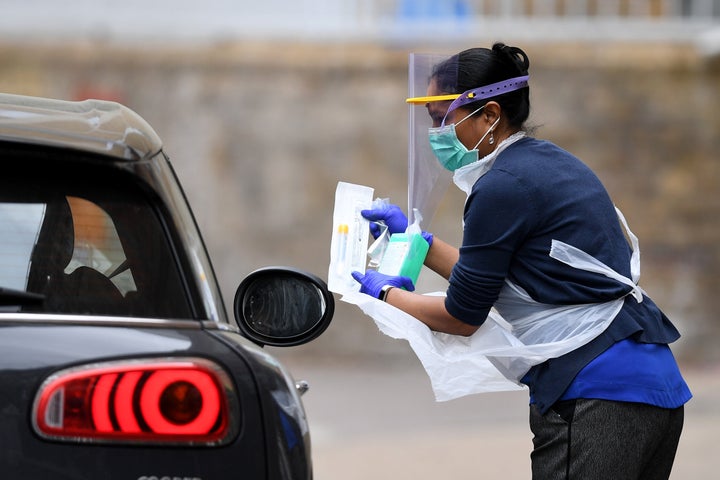Get the latest on coronavirus. Sign up to the Daily Brief for news, explainers, how-tos, opinion and more.
The government has set out five tests to determine whether the UK is ready to lift, or begin lifting, the coronavirus lockdown measures.
We are some way off hitting them all. But what progress has been made? And how far off are we from the targets?
Test 1: The NHS has the capacity to provide critical care right across the UK
The first test is whether Britain has the capacity to look after those seriously ill with coronavirus – which can be measured by spare beds in intensive care.
Hospitals have not been overwhelmed by patients so far in the pandemic, and in some places have been aided by the opening of the new NHS Nightingale sites.
Health secretary Matt Hancock said on Monday that there were 3,190 spare critical care beds in the health service, and that in most parts of the country the number of people in hospital with coronavirus is beginning to fall.
Covid-19 accounts for around 40% of such beds being currently in use, with the numbers of people being admitted to hospital with Covid-19 dropping by 16% from more than 18,000 admitted to around 15,000 during the pandemic.
This test, therefore, appears to have been met.
Test 2: A sustained and consistent fall in daily deaths from coronavirus
Scientists estimate that England’s daily hospital death toll peaked around April 8, and it has been slowly but steadily falling since.
But the picture is less clear when deaths in the community are included, with some suggestions that deaths in care homes may still be increasing.
On Wednesday, coronavirus was linked to 26,097 deaths in the UK to date in a figure that also – for the first time – included deaths in care homes and in the community.
It represents 3,811 more deaths than those previously counted in hospitals for the same period.
The new total means the UK has one of the highest fatality rates in Europe.
After just a day of this extra data, more is needed to be clear whether this test has been met.
Test 3: The rate of infection has decreased to manageable levels across the board
The “R” value – or infection rate – is now thought to be somewhere between 0.5 and 1, meaning that each person infected with the virus passes it on to, on average, less than one other person.
This in turn means the total number of cases is falling. But if R rises above 1, there could be another steep rise in infections.
It is likely this test has been met across the board, but the government will be extremely anxious to ensure the rate of infection does not rise again.
Test 4: Operational challenges including testing and PPE are in hand, with supply able to meet future demand

On Thursday, justice secretary Robert Buckland admitted the government will probably fail to hit its target of testing 100,000 people per day for coronavirus by the end of April, despite promises to the contrary by Hancock.
Speaking to Sky News, Buckland said currently 52,000 people were being tested each day, but added capacity was “rising”.
“Even if we don’t hit it, and it’s probable that we won’t, we will in the next few days,” he said of the 100,000 pledge.
It will not become clear until Friday at the earliest whether the target has been missed.
And while more than a billion items of personal protective equipment (PPE) have been distributed, concerns over shortages remain – particularly among care home staff. For starters, the government hasn’t been able to say how much PPE is actually needed, while acute shortages earlier this month saw an extraordinary instruction to NHS trusts to re-use supposedly single-use equipment, or to downgrade the PPE they were telling staff to use.
Given the global spread of the disease, operational challenges in sourcing PPE may continue for some time. So far, this test does not appear to have been met.
Test 5: Confidence that any adjustments to the current measures will not risk a second peak of infections (that overwhelms the NHS)
Prime minister Boris Johnson said on Monday he would not risk a second peak in the disease by relaxing restrictions too quickly.
But Downing Street came in for questioning a day later when it published its “five tests” document with altered wording, leading to speculation the government is preparing to ease the lockdown restrictions.
Rather than stating that ministers had to be confident an adjustment would not “risk a second peak of infections”, the wording was changed to say no weakening of restrictions would be made that would risk a second peak that “overwhelms the NHS”.
Easing the lockdown will almost certainly lead to more infections and deaths until a vaccine is available, but the NHS will not be considered to be overwhelmed if it maintains critical care capacity (as in point 1).
Hancock said during the No.10 press conference on Tuesday that the NHS had coped with the first peak of infections, which is thought to have occurred around Easter.
The government’s scientific advisers are presenting a series of options to ministers about easing lockdown measures, a combination of which would keep the R value below 1.
Ministers could use the new advice issued to them, along with the altered wording, to lift a number of the social distancing measures in place and help get Britain back to work.

